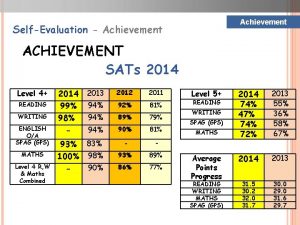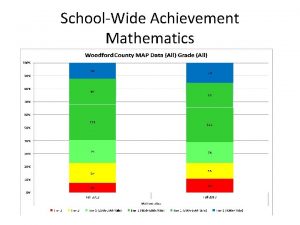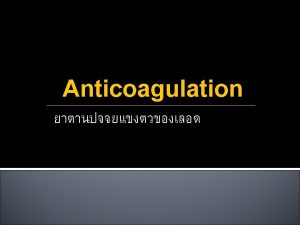Classroom ManagementA Pathway To Student Achievement A Study














- Slides: 14

Classroom Management—A Pathway To Student Achievement: A Study of Fourteen Inner-City Elementary Schools Authors: H. Jerome Freiberg, University of Houston Chris A. Huzinec, Houston Independent School District Stacy M. Templeton, University of Houston Presentation By: Tyler Augedahl

Introduction � The study occurred in the Southwest United States. � 14 schools included as test group � Consistency Management and Cooperative Discipline (CMCD) � Study compared results of math and reading tests of test group to control students � 350 Test Students � 350 Control Students

Introduction Study was conducted to see if their was a link between test scores in reading and math and better classroom management because disruptions: �Steal valuable teaching and learning time �Hurt positive school climates and student performance �Inhibit how and what teachers feel they can teach � Also, zero tolerance programs that result in suspension or expulsion cause students fall farther behind. �

Profile of CMCD � CMCD was founded by the author � CMCD is primarily used as part of reform interventions in inner-city, high poverty communities. � Provides teachers, administrators, students, and other school staff with the tools needed to build community and organizational capacity within their schools. � Emphasizes eliminating problems before they begin by: � Improving school climate and student behavior � Effectively managing instructional time

CMCD Findings � Significantly increases teacher and student attendance � Reduce office discipline referrals � Increase student achievement in Math and Reading � Create healthier school climate � Improve classroom and school learning environment

How does CMCD Work? � Presents teachers with systems to facilitate �Classroom Management �Instructional Organization �Planning �Student Self-discipline �Engaging Learning Environments

Central Themes of CMCD � There are 5 central themes of CMCD �Prevention �Caring �Organization �Cooperation �Community � Almost 100 strategies support the five themes

Method � 700 Students were tested � Test Group: 350 students randomly selected from 14 different schools Schools were matched on similarities in enrollment, percentages of ethnicities, and economically disadvantaged � Pretest was collected in Spring of 1999 and 2000 � Posttest data was collected in the Spring of 2001 and 2002 after two years of CMCD � � Posttest data collected when students were in 4 th, 5 th, and 6 th grade

Method � CMCD is implemented in 3 phases 1. Classroom Implementation 2. School Wide Focus 3. Building Site Capacity

Results CMCD had a statistically significant effect on the reading and math scores of test group when compared to control students � Math Posttest Scores �CMCD students scored in the 67 th percentile �Control students scored in the 50 th percentile � Reading Posttest Scores �CMCD students scored in the 64 th percentile �Control students scored in the 50 th percentile �

Limitations � Change occurs in context � Implementation takes time and doesn’t happen overnight � CMCD only provides management strategies � Does not provide subject based curriculum � Other programs could have contributed to success of test students � Move It Math (MIM) � Success for All (SFA)

Educational Significance of CMCD � More time to teach equals more time to learn: �Fewer interruptions during instruction time �Better classroom organization �Better student engagement �Better teacher planning � Survey of teachers indicated that teachers saved 26 minutes/day as a result of CMCD

Educational Significance of CMCD � Creates a climate for learning �Students are engaged and involved �Teachers and students view each other as partners � Teachers report less stress �Reduces number of mental health days used � Children have important roles in the classroom �Children don’t want to be late or absent

Reference � Freiberg, H. Jerome, Huzinec, Chris A. , Templeton, Stacey M. (2009). Classroom Management—a Pathway to Student Achievement: A Study of Fourteen Inner-City Elementary Schools. The Elementary School Journal. V 110 n 1 pg 63 -80. Available: http: //vnweb. hwwilsonweb. com. wsuproxy. mnpals. net/hww/jumpstart. jhtml? recid=0 bc 05 f 7 a 67 b 1790 e 31070 eb 655 f 153164655 a 324 dda 86 f 32 d 27190 c 0 e 2173634 ee 9899 d 285 ca 5 fa 8&fmt=C
 Student achievement manager login
Student achievement manager login To assess achievement at the end of instruction is
To assess achievement at the end of instruction is American student achievement institute
American student achievement institute Student achievement goals
Student achievement goals American student achievement institute
American student achievement institute Cse smart class
Cse smart class Student diversity in the classroom
Student diversity in the classroom Your last weekend
Your last weekend What did you do in london last weekend
What did you do in london last weekend Uheaa contact
Uheaa contact Class maths student student1 class student string name
Class maths student student1 class student string name National student clearinghouse student tracker
National student clearinghouse student tracker Https://student.freckle.com/#/
Https://student.freckle.com/#/ Teacher:good morning students
Teacher:good morning students Singapore student learning space
Singapore student learning space



























